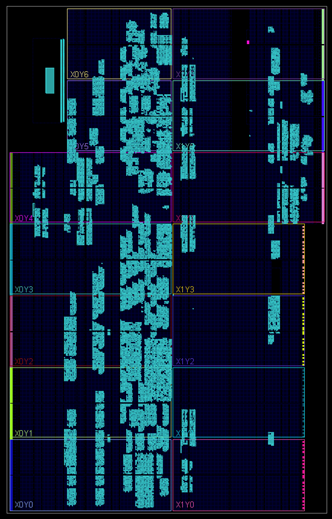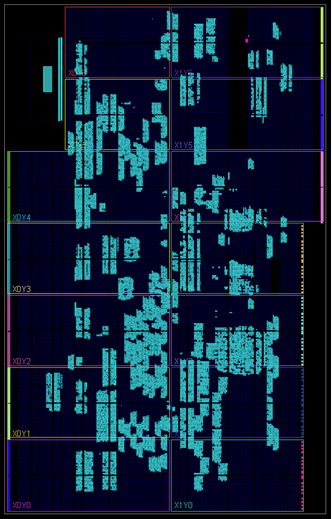Improved Horizontal Block Density¶
Table of Contents
This page aims to describe the algorithm for increasing horizontal block density during placement. It first motivates the need for such an algorithm and then describes implementation details.
When to use the algorithm?¶
The horizontal block density algorithm is not always needed but can be useful in designs with high utilization. If the block design has many IP instances which would use most of the device resources, then such an algorithm to spread the modules across the design is beneficial.
Additionally, the algorithm was developed with the rapid prototyping flow in mind. It is meant to improve quality of results when the flow is automated (no user-provided pblocks or input).
The images below contrast the impact of this algorithm before (left) and after (right) its application.
What are the additional features?¶
At the beginning of the RapidWright flow, each module is assigned a pblock. This step has a significant impact on the quality of the full design placement. During block placement, the pre-implemented modules are placed using a simulated annealing algorithm, essentially, they are moved around continuously on the device to find the placement with the minimum wire length. However, this process of “moving around” the pre-implemented modules is not as trivial as it sounds. The moved module expects the same resources on the new position. Thus, a module cannot be moved anywhere on the device. If many modules have pblocks on the same device columns, they will likely be placed on the same columns during placement. Consequently, some device columns become crowded, while others are not occupied at all. The goal of the “Horizontal Block Density” algorithm is to avoid this scenario.
To explain in greater detail the aspects of this algorithm, we should first consider the original algorithm. When RapidWright chooses pblock constraints for a module, it first checks its resource requirements. It then selects a Tile Pattern that fulfills these requirements. Usually the structure of a device is not uniform, meaning that some tile patterns appear more often than others. If we place our pblock on a tile pattern that repeats often on the device, it will be easier to move it around during placement. RapidWright takes this into account when selecting a tile pattern for a module. However, if many modules use the same resource types, it is highly probable that they will use the same patterns. Thus, some tile columns will be used by many modules, while others will have a lower usage.
The new algorithm checks which patterns are already used by other modules and tries to place the new one on free resources. Each time a module is assigned a pblock, these constraints are written in a file. Because tile patterns can repeat, all the corresponding columns are written, not only the first occurrence of the pattern. Additionally, the number of IP instances is appended. This is important in order to be able to estimate how many resources are left free for a certain pattern. When a new module is processed, it first reads this constraints file. Afterwards, it selects the most frequent pattern with the freest resources.
How to use it?¶
If an environment variable called GLOBAL_PBLOCK is set, the
algorithm considers that the user wants to use the horizontal block
density algorithm. Thus, by setting this variable, the new algorithm
is employed automatically. As the name suggests, this variable will
point to a file where all the pblock constraints will be written. If
you want to instruct the algorithm to avoid certain columns, you can
insert in the file some pblocks using those patterns. Otherwise, it
can simply be an empty file. Removing this variable disables the
algorithm.
How is it implemented?¶
In order to accomplish the desired functionality, the following methods were added:
getAlreadyGenPBlocks() - This method simply reads the already
existent pblock constraints (used by other modules) and stores them in
a map.
createAllPBlocks() - This method creates a map having all
occurrences of a given pattern, not only the first one. This is useful
in order to compute correctly the free resources for a given
pattern. It returns a map with all possible pblocks for a certain
pattern.
checkFreeResources() - This method takes as input one pblock
(multiple if pattern repeats) and checks whether this is already used
by other IPs and how many free resources (= rows) are left.
getSitePBlock() - This was added to support 7 series devices when
selecting a Site. The site is selected based on device, tile type &
whether it is the left or the right margin of the pblock
The core of the algorithm is inside the generatePBlockFromReport()
method. The flow in the beginning, computing feasible patterns
(=enough resources), is the same. After that, a variable called
doHorizDens() checks if horizontal density algorithm is desired or
not. If yes, it goes through the algorithm and then returns to the
caller method. If this is not the case, it simply continues running
the original flow. The new algorithm first reads the global
constraints file and creates a map with already used patterns
(getAlreadyGenPBlocks() method). It actually creates more maps,
for the left, right, upper and lower pblock margins. It then generates
an ordered map called storeBestPattern(), which stores the feasible
patterns depending on the number of free resources. In order to
compute free resources for a given patter, the createAllPBlocks()
and checkFreeResources() are used. The flow then goes through the
storeBestPattern() ordered map and creates the pblock constraints
(only the amount requested by the user).

